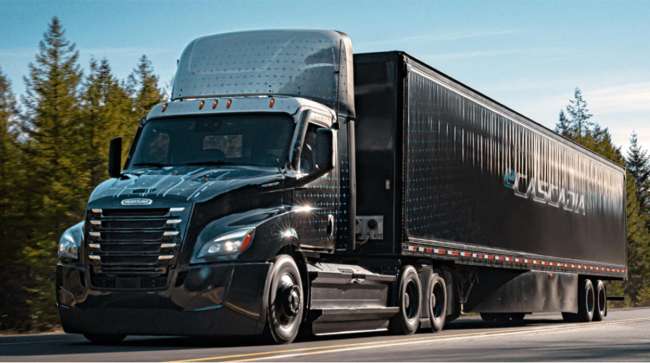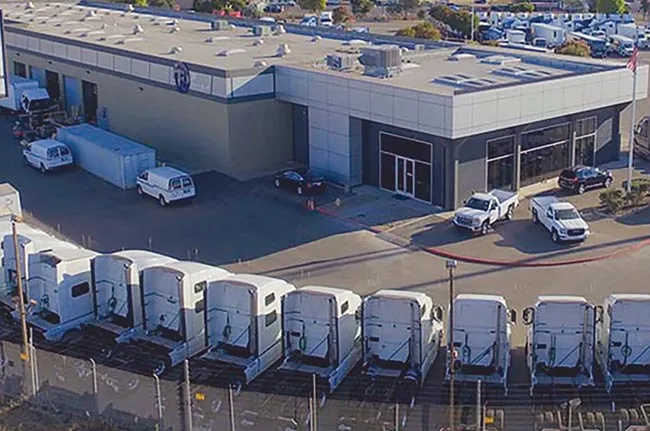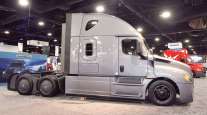Staff Reporter
Forecast Upped for Class 8 Registrations as Fears Ease

[Stay on top of transportation news: Get TTNews in your inbox.]
New registrations for U.S. Class 8 trucks are set to total 249,836 this year, according to S&P Global Mobility, a jump of 12% compared with its expectations at the start of the year as economic headwinds failed to materialize.
The forecast, a proxy for sales, would also be an increase of 1.9% compared with S&P Global Mobility’s calendar year 2022 registrations estimate, Andrej Divis, executive director of global truck research, told Transport Topics.
So far, 2023 has been a much more successful year than expected for truck manufacturers and dealers, with forecasts of a recession by analysts at S&P Global Inc. never coming to pass, Divis said.
Fleets continued replacement and refreshing of their vehicle stock at a relatively robust rate, Antti Lindstrom, S&P Global Mobility principal analyst for commercial vehicle forecasting, added in an email.

Divis
The U.S. economy appears to have avoided the expected recession as a result of “stoic consumer spending in durable and nominal goods, coupled with a resurgence in services, travel and restaurants,” which has boosted freight and truck activity, analysts led by Divis said in a statement.
Supply chain constraints are still there, but less pressing than in 2022 or 2021, so original equipment manufacturers have been able to supply fleets with the trucks that they ordered earlier, and are thus working down order backlogs, Lindstrom said in the email.
New players in the trucking sector are chasing dollar signs in e-commerce and retail, Lindstrom added in a phone interview. The retail sector, especially e-commerce, is booming, he said.
However, within the stronger-than-expected figures, there are pockets of demand weakness, Divis and Lindstrom said.
Some sub-sectors have seen a more noticeable impact from interest rate increases, Divis said. Vocational markets, especially the construction industry, have been hit hardest, he said, noting new home starts have slumped. The construction sector’s weakness has also hurt Class 6 box van sales. Housing starts are expected to continue to be slow, he added.

A TEC Equipment dealership in Oakland, Calif. (TEC Equipment)
Overall, current demand is still strong, as the risk of recession recedes compared with the last two quarters as well as consumer activity remaining resilient, the analysts said.
A slowing of sales is set to be visible by the fourth quarter of 2023, Divis and Lindstrom said.
Demand from owner-operators, which blossomed in the pandemic, is expected to pull back because income is down and interest rates are up, Lindstrom said, adding this has always been the most volatile sector of the longhaul trucking industry. “Only the toughest survive,” he said.
In addition, revenues at big fleet owners have decreased as a result of higher interest rates and the impact on demand as well as challenging freight rates, he said.

Lindstrom
S&P Global Mobility expects Class 8 vehicle sales to drop 13% year-over-year to 218,136 in calendar year 2024. Class 8 vehicle production is also set to ramp down on an hourly and daily basis as a result of the weakening economy, Lindstrom said. Class 8 is always the most cyclical of the classes, he added.
A rebound will be seen in 2025, though, with S&P Global Mobility expecting an 8% year-on-year increase in sales to 236,521 vehicles.
Regardless of U.S. weight class, environmental compliance will be the key driver of demand and production in the coming years, the analysts said. Proposed Environmental Protection Agency greenhouse gas emissions standards are forcing traditional original equipment manufacturers “to re-evaluate their manufacturing and investment strategies,” they said.
The added cost of those tougher regulations will drive more purchases in the middle of the decade, said Lindstrom.
A third tier of the 2027 GHG regulations, combined with the fleet replacement cycle, will likely fuel a strong wave of preemptive buying, according to the analysts, which it said was driving its expectations for 2025 and 2026.
Want more news? Listen to today's daily briefing above or go here for more info
Sales strength will also be driven by the transition toward lower- and zero-emission trucks, especially in California, and the states that follow its lead.
Disruptor brands like Tesla and Nikola will accelerate this transition for their part, the analysts said. Meanwhile, legacy brands are continuing to introduce “cleaner” versions of their existing truck models such as the Freightliner eCascadia and Hino XL8 series, they said.
However, as other observers have previously noted, there will be growing pains, with the transition to hydrogen and fuel cell technologies limited by cost, infrastructure and availability issues, the analysts said.




